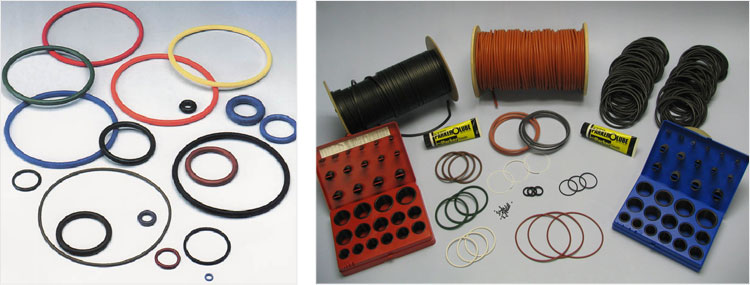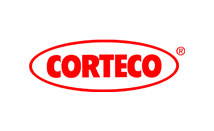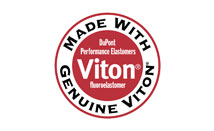O-Ring, NBR Oring, VITON Oring, FKM oring, FPM Oring, Silicone Oring, EPDM Oring, HNBR Oring, Kalrez / FFKM Oring, Oring Assortment Kit, Oring Splicing Kit.

Singapore Largest Leading Stock List For O-Ring
- Over 7000 Sizes available
- AS 568 Standard O-Ring Size
- Metric Standard O-Ring Size
- All Standards includes: U.S, British, JIS and DIN Standards.
The Use of O-Ring
Yong Leng Tdg Co offers wide range of O-Ring in different sizes and application purposes. These O-Rings are typically manufactured from elastomeric material and are cut in torus or donut shape. These effectively form a static or dynamic seal to applications in need of secured and tight enclosure against any loss of pressure or leak on materials being contained.
Static seal is achieved using specific o-ring that holds a pressure or maintains pre-set range of vacuum while Dynamic seal is necessary when there are motions happening in between surface that can either be reciprocating or rotating. When installed, these o-rings compresses and deforms slightly into the free space within the groove thus, forming stable sealing feature. There are special o-rings available that are capable of handling or sealing thousands of PSI pressure. Being one of the most common seals used in the design of machines, o-rings are manufactured with lesser expensive materials and easy procedures, making the seal affordable to every industry. With its reliable and simple mounting requirements, the o-rings are typically described by material com,position and hardness. These are made available with variant sizes as per specific industry standards and are being measured through its inner and outer diameters.
Select from our wide selection of o-rings according to metric or inch sizes, chemical compatibility, quality, quantity, cost, application temperature, lubrication requirements and sealing pressure.
O-Ring Material Applications
DESCRIPTION
Industry’s most widely used and economical elastomer, Nitrile combines excellent resistance to petroleum-based oils and fuels, silicone greases, hydraulic fluids, water and alcohols, with a good balance of such desirable working properties as low compression set, high tensile strength, and high abrasion resistance.
KEY USE(S)
Oil resistant applications of all types. Low temperature military uses. Off-road equipment. Automotive, marine, aircraft fuel systems. Can be compounded for FDA applications.
TEMPERATURE RANGE
Standard Compound: -40° to +257°F
HARDNESS (SHORE A)
40 to 90.
FEATURES
Comprised of the copolymer butadiene and acrylonitrile, in varying proportions. Compounds can be formulated for service temperature ranging from -85°F to +275°F. Use of Carboxylated Nitrile can have superior abrasion resistance, while still having improved oil resistance.
LIMITATIONS
Nitrile compounds are attached by small amounts of Ozone. Phthalate type plasticizers are commonly used in compounding Nitrile Rubber. These plasticizers can migrate out and cause problems with certain plastics. Also, new regulations on certain phthalates have limited their use.
DESCRIPTION
Combining high temperature resistance with outstanding chemical resistance, Fluorocarbon-based compounds approach the ideal for a universal O-ring material.
KEY USE(S)
Seals for aircraft engines. Seals for automotive fuel handling systems. High temperature/low compression set applications. Wide chemical exposure situations. Hard vacuum service.
TEMPERATURE RANGE
Standard Compound: -13° to +446°F
Special Compound: -40° to +446°F
HARDNESS (SHORE A)
55 to 90.
FEATURES
High fluorine grades offer higher resistance to swell in high octane and oxygenated fuel blends. This give superior performance in Ethanol/Methanol blended gasoline. Base resistant grades offer improved resistance to amine based oil protectants found in new transmission oils. Also, improved resistant to steam for higher temperature services. Low temperature bases can improve performance to -40°F.
New Polymers being offered have improved chemical resistance and low temperature performance.
Viton® Extreme™ ETP offers similar chemical compatibility as Kalrez™ with temperature performance with a TR(10) of -40°F and brittleness to -76°.
LIMITATIONS
Fluorocarbons (Viton®s) are not recommended for exposure to ketones, amines, low molecular weight esters and ethers, nitro hydrocarbons, hot hydrofluoric or chlorosulfonic acids, or Skydrol® fluids. They are also not recommended for situations requiring good low temperature flexibility.
DESCRIPTION
A copolymer of ethylene and propylene (EPR), combined with a third comonomer adiene(EPDM), Ethylene Propylene has gained wide seal industry acceptance for its excellent ozone and chemical resistance characteristics.
KEY USE(S)
Outdoor weather resistant uses. Automotive brake systems. Automobile cooling systems. Water applications. Low torque drive belts.
TEMPERATURE RANGE
Standard Compound: -40° to +275°F
Special Compound: -67° to +302°F
HARDNESS (SHORE A)
40 to 95.
FEATURES
When compounded using peroxide curing agents high temperature service can reach +350°F. Good resistance to acids and solvents (i.e. MEK and Acetone).
LIMITATIONS
Have no resistance to hydrocarbon fluids.
DESCRIPTION
A group of elastomers, made from silicon, oxygen, and hydrogen, Silicones are renowned for their retention of flexibility and low compression set characteristics, within one of the widest working temperature ranges for elastomers.
KEY USE(S)
Static seals in extreme temperature situations. Seals for medical devices, compatible with FDA regulations.
TEMPERATURE RANGE
Standard Compound: -85° to +400°F
HARDNESS (SHORE A)
20 to 80
FEATURES
Phenyl (PVMQ) based silicones can perform to -85°F. New polymers can take short term to 600°F.
LIMITATIONS
Generally, low abrasion and tear resistance, and high friction characteristics preclude silicones from effectively sealing some dynamic applications. Silicones are also highly permeable to gases and are generally not recommended for exposure to ketones (MEK,acetone) or concentrated acids.
DESCRIPTION
Hydrogenated nitrile is a synthetic polymer that results from the hydrogenation of nitrile rubber (NBR). Superior mechanical characteristics, particularly high strength, helps reduce extrusion and wear.
TEMPERATURE RANGE
Heat resistance:
• Up to 150°C (300°F) Cold fl exibility
• Down to approximately -48°C (-55°F)
CHEMICAL RESISTANCE
• Aliphatic hydrocarbons.
• Vegetable and animal fats and oils.
• HFA, HFB and HFC hydraulic fl uids.
• Dilute acids, bases and salt solutions at moderate temperatures.
• Water and steam up to 149°C (300°F).
• Ozone, aging and weathering.
LIMITATIONS
Not compatible with:
• Chlorinated hydrocarbons.
• Polar solvents (ketones, esters and ethers).
• Strong acids.
DESCRIPTION
Oring Resist over 1,800 different chemicals, while offering the high temperature stability of PTFE (TEFLON) 327 Degree Celsius. Use in highly aggressive chemical processing, semiconductor wafer fabrication, pharmaceutical, oil and gas recovery, and aerospace applications.



